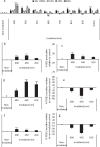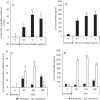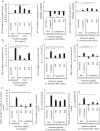Photobiomodulation of oral fibroblasts stimulated with periodontal pathogens
- PMID: 33991267
- PMCID: PMC8593050
- DOI: 10.1007/s10103-021-03331-z
Photobiomodulation of oral fibroblasts stimulated with periodontal pathogens
Abstract
Photobiomodulation (PBM) utilises light energy to treat oral disease, periodontitis. However, there remains inconsistency in the reporting of treatment parameters and a lack of knowledge as to how PBM elicits its molecular effects in vitro. Therefore, this study aimed to establish the potential immunomodulatory effects of blue and near infra-red light irradiation on gingival fibroblasts (GFs), a key cell involved in the pathogenesis of periodontitis. GFs were seeded in 96-well plates in media + / - Escherichia coli lipopolysaccharide (LPS 1 μg/ml), or heat-killed Fusobacterium nucleatum (F. nucleatum, 100:1MOI) or Porphyromonas gingivalis (P. gingivalis, 500:1MOI). Cultures were incubated overnight and subsequently irradiated using a bespoke radiometrically calibrated LED array (400-830 nm, irradiance: 24 mW/cm2 dose: 5.76 J/cm2). Effects of PBM on mitochondrial activity (3-(4,5-dimethylthiazol-2-yl)-2,5-diphenyltetrazolium bromide (MTT) and adenosine triphosphate (ATP) assays, total reactive oxygen species production (ROS assay) and pro-inflammatory/cytokine response (interleukin-8 (IL-8) and tumour growth factor-β1 (TGFβ1)) were assessed 24 h post-irradiation. Data were analysed using one-way ANOVA followed by the Tukey test. Irradiation of untreated (no inflammatory stimulus) cultures at 400 nm induced 15%, 27% and 13% increases in MTT, ROS and IL-8 levels, respectively (p < 0.05). Exposure with 450 nm light following application of P. gingivalis, F. nucleatum or LPS induced significant decreases in TGFβ1 secretion relative to their bacterially stimulated controls (p < 0.001). Following stimulation with P. gingivalis, 400 nm irradiation induced 14% increases in MTT, respectively, relative to bacteria-stimulated controls (p < 0.05). These findings could identify important irradiation parameters to enable management of the hyper-inflammatory response characteristic of periodontitis.
Keywords: Fibroblast; Mitochondria; PBM; Periodontitis; Photobiomodulation.
© 2021. The Author(s).
Conflict of interest statement
The authors declare no competing interests.
Figures




Similar articles
-
NOX1/2 activation in human gingival fibroblasts by Fusobacterium nucleatum facilitates attachment of Porphyromonas gingivalis.Arch Microbiol. 2016 Aug;198(6):573-83. doi: 10.1007/s00203-016-1223-7. Epub 2016 Apr 12. Arch Microbiol. 2016. PMID: 27071620
-
Synergistic induction of PGE2 by oral pathogens and TNF promotes gingival fibroblast-driven stromal-immune cross-talk in periodontitis.mBio. 2025 May 14;16(5):e0004625. doi: 10.1128/mbio.00046-25. Epub 2025 Apr 3. mBio. 2025. PMID: 40178270 Free PMC article.
-
Effects of cranberry components on human aggressive periodontitis gingival fibroblasts.J Periodontal Res. 2013 Aug;48(4):433-42. doi: 10.1111/jre.12023. Epub 2012 Oct 28. J Periodontal Res. 2013. PMID: 23106206
-
Porphyromonas gingivalis lipopolysaccharide signaling in gingival fibroblasts-CD14 and Toll-like receptors.Crit Rev Oral Biol Med. 2002;13(2):132-42. doi: 10.1177/154411130201300204. Crit Rev Oral Biol Med. 2002. PMID: 12097356 Review.
-
Biological activities of lipopolysaccharides from oral bacteria and their relevance to the pathogenesis of chronic periodontitis.Sci Prog. 1995;78 ( Pt 1):19-34. Sci Prog. 1995. PMID: 7597416 Review.
Cited by
-
The implication of blue light-emitting diode on mesenchymal stem cells: a systematic review.Lasers Med Sci. 2023 Nov 20;38(1):267. doi: 10.1007/s10103-023-03908-w. Lasers Med Sci. 2023. PMID: 37981584
-
In Vivo and In Vitro Response to a Regenerative Dental Scaffold.Materials (Basel). 2024 Nov 4;17(21):5384. doi: 10.3390/ma17215384. Materials (Basel). 2024. PMID: 39517658 Free PMC article.
-
Blue light-emitting diode promotes mineralization of stem cells from the apical papilla via cryptochrome 1/Wnt/β-catenin signaling.J Mol Histol. 2025 Apr 1;56(2):125. doi: 10.1007/s10735-025-10400-y. J Mol Histol. 2025. PMID: 40167571
References
-
- Mester E, Szende B, Gärtner P. The effect of laser beams on the growth of hair in mice. Radiobiol Radiother. 1968;9(5):621–626. - PubMed
MeSH terms
Substances
LinkOut - more resources
Full Text Sources
Other Literature Sources

